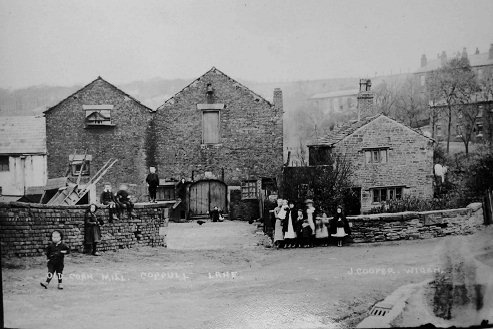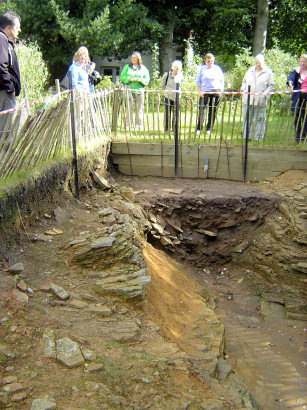
Oxford Archaeology North have just completed a desktop survey of the Sutton Corn Mill which, together with the nearby Bottling Wood Community, thrived in the Douglas Valley in the 19th century. The study was commissioned by the Environment Agency who have plans to build a dam across the valley at this point as part of a scheme to reduce the risk of flooding from the River. A corn or fulling mill is said to have existed here in the Middle Ages, although no direct evidence exist now. The first depiction of a mill here comes from the early 18th century. By the middle of the 19th century the small community of Bottling Wood had been established consisting of a few streets and a public house. However by the beginning of the 20th century milling had ceased and the mill had been converted into a farm. The community was also on the decline and in 1927 it was declared an 'Unhealthy Area' and designated for demolition. It took some time to get everybody re-housed in the new estate which was being built nearby, and cost nearly £6000. However by 1933 the whole site, including the mill, had been cleared and the area landscaped. As part of the study, the Agency have also commissioned a GPR (Ground Penetrating Radar) survey of the site in an attempt to locate any archaeological remains. If this is successful then excavations will follow which will be funded by the Agency. If you want to read the full report I will have a copy with me at the meeting.

Mellor
Last month's trip to Mellor turned out to be a quite a successful day out (despite the low turnout). Our small but enthusiastic band teamed up with Dot Waring and her friends from Darwen Historical Society for an expertly guided tour around this multiperiod site. Despite the recent bad weather, we managed to select a glorious day and views from the top of the hill at Mellor were stunning. Judy Cooper, our guide for the day, introduced us to the many aspects of the site starting with the Pre-historic, going through the Roman-British and finishing with the Medieval. The most fascinating feature was a huge rock-cut trench which has been found in a number of places circulating around the whole hilltop site. Pottery evidence gives a date of construction to around the middle of the 1st millennium BC suggesting it formed part of the defensive structure of an Iron Age hill fort. Within the enclosed area there was a complete jumble of archaeological features from different periods for the archaeologists to unravel. In particular there was a series of circular drip trenches for round houses dating from the Roman period (this suggests a tribal leader who was on good terms with the Romans). In another area we saw evidence for a series of huge post holes representing a large Medieval hall. Historical evidence attributes it to the De Melleurs who in the 13th century were the Knight's Foresters of the Peak. The hall was next to the church which in itself had some interesting features e.g. a pulpit, reputedly the oldest in the country, and a font whose strange stone carvings suggest a preconquest date. After the tour we travelled to the Pack House Inn near New Mills for an excellent lunch, leaving just enough time for a quick visit to the 16th century Tudor hall at Bramhall. If you want to find out more about Mellor visit their excellent website at www.mellorheritage.org.uk.
CBA NW Autumn Conference
This year's conference is entitled "Roman NW England:- Hinterland or 'Indian Country'?" and will be held at the Grosvenor Museum, Chester on the 18th October (more details on speakers here, and how to book your place here).
Next Meeting
Wednesday 1st October at the District Scout HQ (Baden Powell Centre) in Greenough Street, starting at 7.30 pm as usual. Our speaker this month is Norman Redhead (County Archaeologist for Greater Manchester) who will be bringing us up to date with the latest Roman excavations around Manchester.
Hope to see you there B.A.
|



